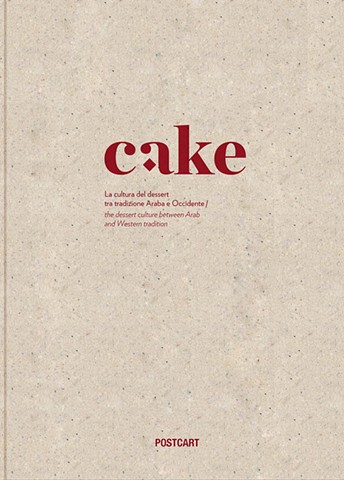Manuela De Leonardis
Cake
by Manuela De Leonardis
Cuisine as an all-around sensory experience: aesthetic research, intercultural language, pleasure of the palate. The right ingredients to introduce Cake. The dessert culture between Arab and Western traditions, a book project designed by Marimo – brand life designers and published by Postcart in 2013 where a found object -a book of recipes- is the basis for comparison of the dessert culture between the Arab world and the West, but also the starting point for a dialogue involving 19 international artists.
Cake is a book of art and cooking that contains a dialogue between recipes and the works of nineteen international artists - Hassan Al-Meer, Paolo Angelosanto, Yto Barrada, Beatrice Catanzaro, Maimuna Feroze-Nana, Parastou Forouhar, Maïmouna Patrizia Guerresi, Susan Harbage Page, Reiko Hiramatsu, Uttam Kumar Karmaker, Silvia Levenson, Loredana Longo, MAD_Angela Ferrara e Dino Lorusso, Şükran Moral, Ketna Patel, Pushpamala N., Anton Roca, Jack Sal, Larissa Sansour - who have interpreted its content. A voyage through knowledge; contaminating languages that are characterized by flavours, colours, and various aromas.
The idea of Cake comes from a little treasure that I bought in a “charity shop” on Kensington High Street, London, in May 2012: an old notebook with a dark hardback cover, grid paper pages turned yellow with age, measuring 17x23x1 cm. The pages are filled with writings made with various pens and are written from right to left.
With blue ink, the recipes are meticulously written in Arabic and French (often the ingredients are listed in French and explanations in Arabic); over 60 recipes for sweets - Mascot au chocolat, Koul Wal Ishkur, Pain d’Espagne, Amandine, Biscuits à l’Anis - many of which are associated with female names: Gateau chocolat Rose, Biscuit Ely, Croissant, Biscuit Linda, Sfouf Souad, Tarte Laurice, Kataif Souad, Gateau Tania, Tarte Hélène, Petits-fours Mary Karkalla…
A female hand - anonymous - on the cover (using a pin to attach it), a square of paper on which she transcribes the recipe for Cake: 6 eggs, 300 gr. of butter, 400 gr. sugar, 400 gr. flour + 2 tablespoons of baking powder, 2 cups of raisins + nuts.
East and West, mediated by the blue Mediterranean, are reinforced in the pages of this manuscript, of which we do not know the origin. The analysis of the Arabic script correlates it to the Middle East, in particular to Lebanon. Among the Arabic recipes, in fact, is that of the Sfouf, a typically Lebanese dessert. The author has written her recipes around 1960/70. This female voice, that single which becomes a choral track when the mapping of recipes submitted by other women (sisters, mothers, aunts, cousins, friends, or acquaintances), recalls a similar path: that of women in Nablus, which under the direction of Fatima Khaddoumi and Italian Cristina Bottigella and Beatrice Catanzaro, gave birth to Bait al Karama cookery School, the first international cooking school and Palestinian Slow Food Convivium in Palestine. Bait al Karama (Dignity House) seeks to combine a social enterprise guided by the Palestinian culinary culture with the activity of artistic, historical, and culinary arts, with the aim of creating jobs for women who live in the Old City of Nablus. To these resourceful and creative women goes the support of Cake, with the hope that this voyage through cooking and the arts can help overcome barriers, visible and invisible.
